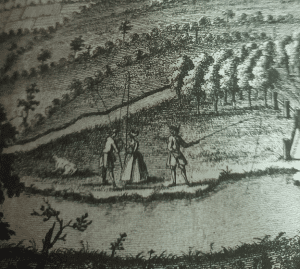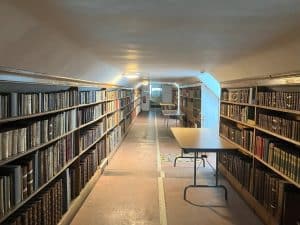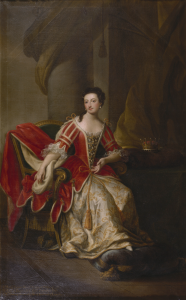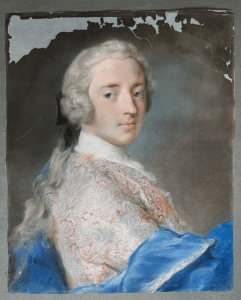
Thomas Dempster, Thomas Coke, and De Eturia Regali
July 31, 2023 | Treasure tales and archive snippets | 5 minute read
There’s a new display in the Chapel Gallery at Holkham, and Katherine Hardwick, Collections Coordinator, is here to tell us all about it.
Thomas Coke (1697-1759), 1st Earl of Leicester and builder of Holkham Hall collected many amazing paintings, sculpture, books and manuscripts during his Grand Tour, undertaken between 1712 and 1718. Among the remarkable things he brought back was a manuscript detailing the history of the Etruscan civilisation, written in the early 1600s by the Scottish historian Thomas Dempster. Not only did Coke purchase the work, but he also sponsored the publication of the text and commissioned the accompanying illustrations. The first volume of what became known as De Eturia Regali was published in 1723, and here we celebrate the publication of this work.
Thomas Dempster (1579-1625) had an obscure and eventful life, which is mostly known today through his autobiography.
He was born in Aberdeenshire to a Catholic family in an increasingly Protestant Scotland. He apparently showed an early and precocious intellect, supposedly learning the alphabet in a single hour at the age of 3. He was sent to Grammar School in Aberdeen, and then at an early age matriculated to Pembroke College, Cambridge.

Whilst he was studying at Cambridge, a family feud broke out when his elder brother, James, married their father’s mistress. As a result, James was disinherited, and in anger, attacked and maimed their father. James then became an outlaw, surviving as a pirate around Shetland and Orkney. As a result of this quarrel, Thomas’ uncles decided he should be sent abroad to continue his education, in order to put as much distance between his talents and his dysfunctional family as possible.
He first moved to Paris where he was sponsored to attend the Scots College at the University. This college was being used as a training ground for priests intended to follow an invading army to Scotland and reconvert it to the Catholic cause. His education was subsequently diverted to the Scots College at the University of Douai – which had been founded by Philip II of Spain as part of his military build-up against England.
Following his graduation from Douai he returned to Paris to become a doctor of canon law, and received his first position as professor at the age of 17. Throughout his career, he proved to be especially skilled at making enemies through his proud and outspoken nature; he never stayed in any one post for very long, travelling around Spain, France, and briefly England as an itinerant professor, being forced from each position by a fight.
Eventually he was appointed professor at Pisa, where he was commissioned by Grand Duke Cosimo II to write a definitive history of the Etruscans, compiled between 1616-1619. This work – now known as De Etruria Regali – was the defining commission of his life, and he often worked upwards of 14 hours on the volume. The work was gifted to Cosmio by Dempster in 1619.
Ultimately, another quarrel ended his stay in Pisa and he finished his life as professor at Bologna, one of the most famous institutions of the day. He had certainly achieved some degree of fame and success, and he was made a knight and given a pension by Pope Urban VIII. He was ultimately killed by another feud – his wife ran away with a student and in pursuing them he caught a fever. He died shortly afterwards, aged either 46 or 50.
Fast-forward nearly 100-years, to the period between 1712 and 1718 when Thomas Coke, builder of Holkham Hall, visited Florence on several occasions as part of his Grand Tour. During one of his visits to the city, he became aware of the Dempster Manuscript, which was eventually purchased for him in July 1719 by his tutor Thomas Hobart. Coke then decided to finance the publication of the manuscript, and left it in Florence for work to be completed. The entire production cost approximately 2,000 Florentine Scudi.

Work was entrusted to Filippo Buonarotti (1661-1733), the celebrated antiquarian who had made his reputation with studies of Imperial bronze coins and medals of Roman emperors. Coke and Buonarotti are known to have met on a number of occasions, and there are annotations believed to be by Buonarotti on one of the volumes of Livy, purchased by Thomas Coke for the Holkham library.
Buonarotti edited Dempster’s text, included his own commentary, and commissioned 93 illustrations to accompany the work. These illustrations are important, as they were based on archaeological remains rather than on written sources, and so laid the foundations for modern archaeology. The work was finally published between 1723 and 1726 and dedicated to Cosimo III and his successor Gian Gastone de Medici, the last Medici Grand Duke of Tuscany.
A copy of the work, the original manuscript, the drawings, and the copper plates used to make the engravings were sent back to Thomas Coke in London and remain part of Holkham’s collection. The drawings and copper plates were rediscovered relatively recently, found in the attics by the 5th Earl of Leicester in 1964. The drawings were found in the 18th century leather wallet in which they had been sent from Italy. They now allow us to tell the complete story of the publication of this manuscript, from hand written text to printed volume, with all the accompanying drawings, printing plates, and accounts.
Come and see them on display in the Chapel Gallery until September. Book your Hall tickets here.





